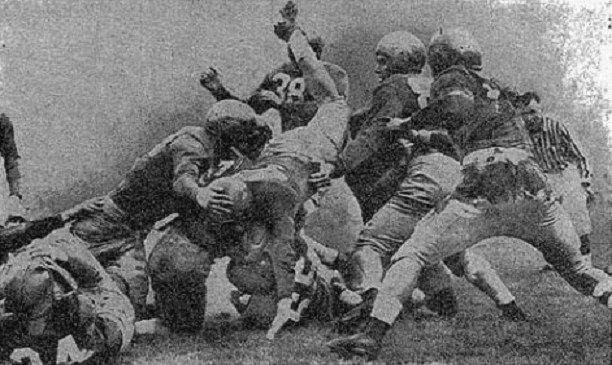


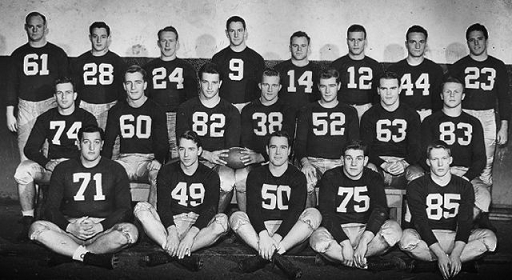
| Indiana (1-8) | 49-6 | |
| at Washington (3-7) | 27-7 | |
| at Purdue (4-5) | 35-12 | |
| Tulane (7-2-1) | 46-7 | #24 |
| (Baltimore) Navy (3-5-1) | 40-0 | |
| at Michigan State (6-3) | 34-21 | #21 |
| (Bronx) North Carolina (7-4) | 42-6 | (#28) |
| Iowa (4-5) | 28-7 | |
| Southern Cal (5-3-1) | 32-0 | #12 |
| at Southern Methodist (5-4-1) | 27-20 | #17 |
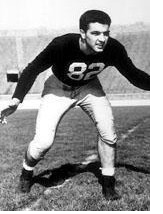 This was Notre Dame's 7th consensus MNC, following mythical titles in 1924, 1929, 1930, 1943, 1946, and 1947.
I covered their Hall of Fame coach, Frank Leahy, in the linked 1943
article. This was his 5th MNC, the first coming at Boston College
in 1940, the other 4 at Notre Dame.
Because he had left Notre Dame due to the war in 1944 and 1945, this
was his 4th MNC in his last 5 years coaching at Notre Dame.
This was Notre Dame's 7th consensus MNC, following mythical titles in 1924, 1929, 1930, 1943, 1946, and 1947.
I covered their Hall of Fame coach, Frank Leahy, in the linked 1943
article. This was his 5th MNC, the first coming at Boston College
in 1940, the other 4 at Notre Dame.
Because he had left Notre Dame due to the war in 1944 and 1945, this
was his 4th MNC in his last 5 years coaching at Notre Dame.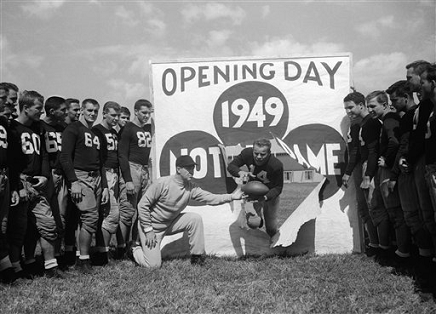
| at Boston College (4-4-1) | 46-0 | |
| Texas A&M (1-8-1) | 33-13 | |
| (Dallas) Texas (6-4) | 20-14 | #15 |
| Kansas (5-5) | 48-26 | |
| at Nebraska (4-5) | 48-0 | |
| Iowa State (5-3-1) | 34-7 | |
| at Kansas State (2-8) | 39-0 | |
| at Missouri (7-4) | 27-7 | (#30-40) |
| Santa Clara (8-2-1) | 28-21 | #10 |
| Oklahoma State (4-4-2) | 41-0 | |
| Sugar Bowl Louisiana State (8-3) | 35-0 | #19 |
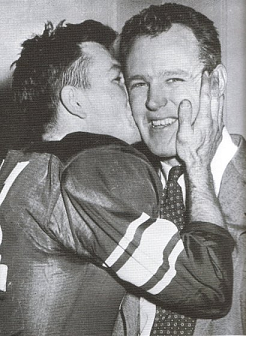 Oklahoma's
history as a football power began in 1946. Prior to that, they rarely
made waves nationally. They had been ranked in the 1938 and 1939 AP
polls, and had there been an AP poll top 25 1901-1935, they likely
would have been rated 3 more times. So in 45 seasons prior to 1946,
they were top 25 just 5 times. After 1946, however, they became a top
25 fixture, and in fact they are probably the top football program 1946-present. How did they become such an overnight sensation out of nowhere? Cold, hard cash, of course.
Oklahoma's
history as a football power began in 1946. Prior to that, they rarely
made waves nationally. They had been ranked in the 1938 and 1939 AP
polls, and had there been an AP poll top 25 1901-1935, they likely
would have been rated 3 more times. So in 45 seasons prior to 1946,
they were top 25 just 5 times. After 1946, however, they became a top
25 fixture, and in fact they are probably the top football program 1946-present. How did they become such an overnight sensation out of nowhere? Cold, hard cash, of course.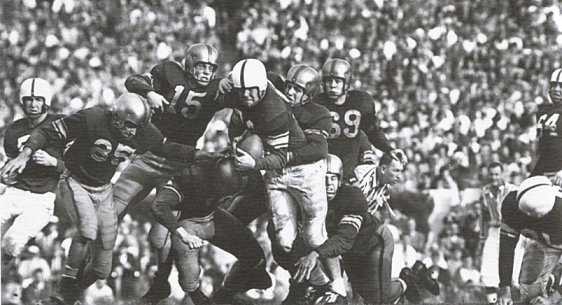
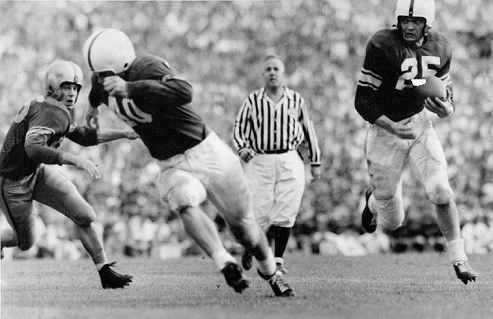
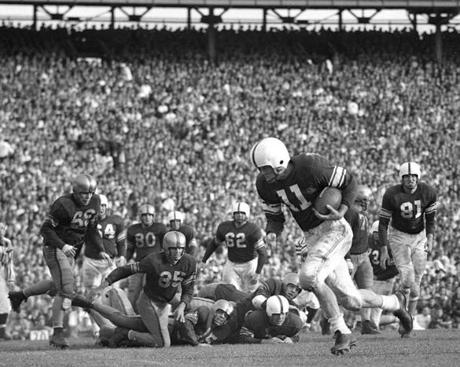
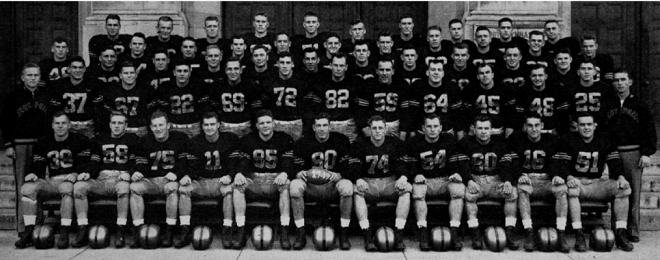
| Davidson (2-8) | 47-7 | |
| Penn State (5-4) | 42-7 | |
| at Michigan (6-2-1) | 21-7 | #5 |
| at Harvard (1-8) | 54-14 | |
| Columbia (2-7) | 63-6 | |
| Virginia Military Institute (3-5-1) | 40-14 | |
| Fordham (5-3) | 35-0 | |
| at Penn (4-4) | 14-13 | (#32-40) |
| (Philadelphia) Navy (3-5-1) | 38-0 |
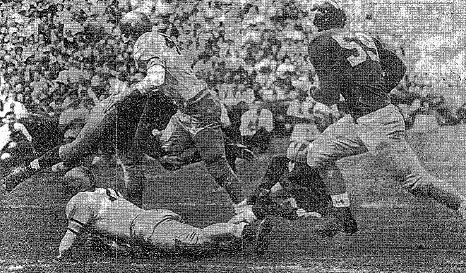
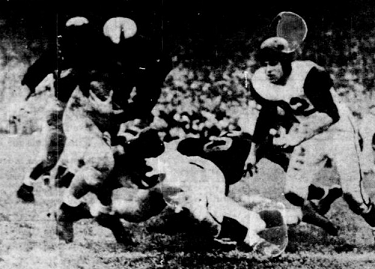
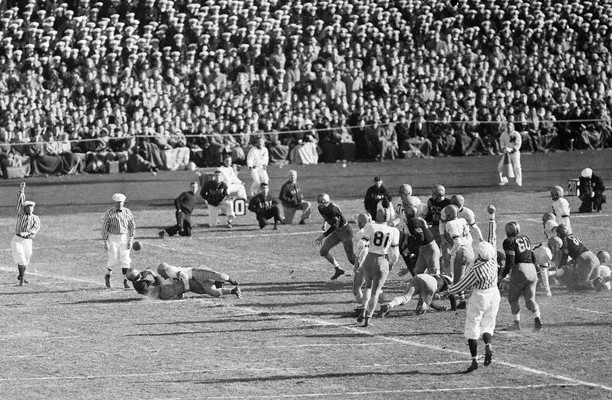
| Notre Dame 10-0 | Oklahoma 11-0 | Army 9-0 | ||||||||||||||||||||||||||||||||||||
|---|---|---|---|---|---|---|---|---|---|---|---|---|---|---|---|---|---|---|---|---|---|---|---|---|---|---|---|---|---|---|---|---|---|---|---|---|---|---|
|
|
|
||||||||||||||||||||||||||||||||||||
| 1) Boand
(math system) |
5.0 |
| 2) AP Poll Poling (math) |
4.94 |
| 5) DeVold (math) | 4.93 |
| 6)
College
Football Researchers Association Billingsley (math) |
4.89 |
| 7) National Championship Foundation | 4.74 |
| 8) Litkenhous (math) | 4.69 |
| 9) Houlgate (math) | 4.53 |
| 10) Berryman (math) | 4.42 |
| 11) Dunkel (math) | 4.37 |
| 12) Sagarin (math) | 4.34 |
| 13) Helms Foundation | 4.31 |
| 14) Sagarin-ELO (math) | 4.24 |
| 15) Williamson (math) | 3.81 |
| 1) Boand (math system) | 4.26 |
| 2) College Football Researchers Association | 4.22 |
| 3) Poling (math) | 4.11 |
| 4) Helms | 4.09 |
| 5) Sagarin-ELO (math) | 4.06 |
| 6) National Championship Foundation | 3.96 |
| 7) Dickinson (math) | 3.49 |
| 8) Houlgate (math) | 3.35 |
| 9) Billingsley (math) | 3.34 |
| 10) Sagarin (math) | 3.28 |
| 11) Parke Davis | 2.77 |
| 1) Houlgate (math system) | 4.5 |
| 2) Helms | 4.3 |
| 3) Parke Davis | 4.2 |
| 4) National Championship Foundation | 3.7 |
| 5) Billingsley (math) | 3.6 |